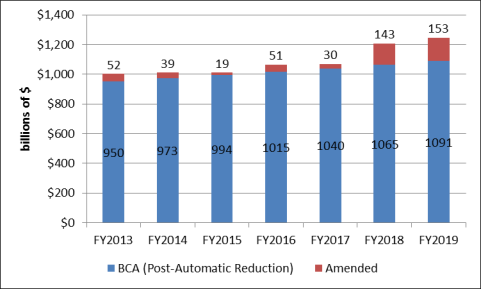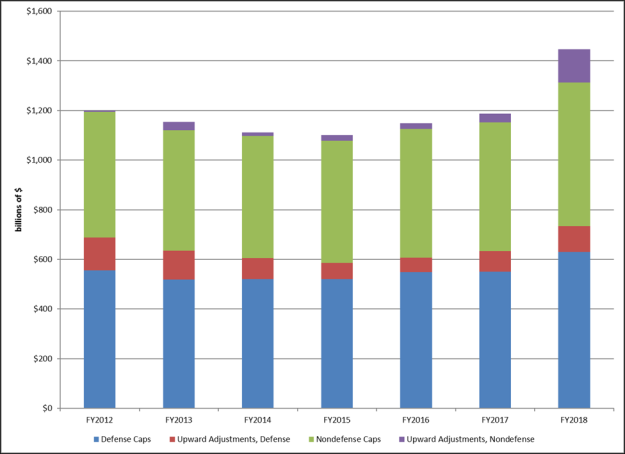Discretionary Spending Levels Under the Bipartisan Budget Act of 2018
On February 9, 2018, the Bipartisan Budget Act of 2018 (BBA 2018) was signed into law as P.L. 115-123. Among other things, it raised the discretionary spending caps for fiscal years 2018 and 2019 originally implemented by the Budget Control Act of 2011 (BCA; P.L. 112-25). BBA 2018 reverses $80 billion of the $97 billion of discretionary spending cuts enacted by the BCA as amended for FY2018.
The BCA and Discretionary Spending
The BCA affected discretionary spending in two ways: (1) caps on discretionary budget authority, divided between defense and nondefense programs, which went into effect in FY2012 and (2) $1.2 trillion in automatic spending reductions beginning in FY2013 that included annual downward reductions to those discretionary caps. The caps essentially limit the amount of spending through the annual appropriations process for that time period, with adjustments permitted for certain purposes. Cap levels are enforced through a sequestration process (spending cuts that are automatically triggered if cap levels are breached).
The BCA contained a variety of measures intended to reduce budget deficits by $2.1 trillion over the FY2012-FY2021 period. Discretionary spending reductions were projected to reduce the deficit by roughly $1.5 trillion over 10 years; the remaining deficit reduction was provided through lower debt servicing costs and automatic reductions to certain mandatory spending accounts and changes to federal student loan programs. For a more detailed analysis of the BCA, see CRS Report R44874, The Budget Control Act: Frequently Asked Questions.
BBA 2018 and Discretionary Spending Subject to the BCA Caps
BBA 2018 increases the discretionary cap levels for both defense and nondefense programs in FY2018 and FY2019 relative to the caps (in effect after the automatic spending reduction took effect) that would have prevailed absent these statutory changes. For FY2018, it raises the discretionary cap on defense to $629 billion (an $80 billion increase) and raises the nondefense cap to $579 billion (a $63 billion increase). The FY2019 discretionary caps are increased to $647 billion for defense (an increase of $85 billion) and to $597 billion for nondefense (an increase of $68 billion). BBA 2018 does not adjust the discretionary caps in FY2020 and FY2021, the last years for which discretionary caps are provided under the BCA.
Table 1 tracks Congressional Budget Office (CBO) projections of discretionary budget authority subject to the BCA caps from before enactment of the BCA (in August 2011) through the enactment of BBA 2018. The BBA cap levels are higher than the ones they replace—which reflect the automatic cap reductions required under the BCA—as well as the BCA's initial cap levels. However, the BBA 2018 caps are still lower than CBO's pre-BCA baseline projection for spending subject to the caps in FY2018 and FY2019. Overall, current projected discretionary defense budget authority subject to the caps is $17 billion below CBO's pre-BCA baseline for both FY2018 and FY2019. Current projected budget authority for nondefense programs is $27 billion and $25 billion below the pre-BCA baseline for FY2018 and FY2019, respectively.
Table 1. Discretionary Budget Authority Limits Under the BCA as Amended, FY2018-2019
(in billions of dollars)
|
Pre-BCA Baseline |
BCA Initial Caps |
Automatic Cap Reductions |
BBA 2018 Caps |
||||||
|
FY |
Discretionary Caps |
Level |
Change from |
=Level |
Change from |
Change from Pre-BCA Baseline |
=Level |
Change from |
=Level |
|
2018 |
Defense |
646 |
-43 |
603 |
-54 |
-97 |
549 |
+80 |
629 |
|
Nondefense |
606 |
-53 |
553 |
-37 |
-90 |
516 |
+63 |
579 |
|
|
2019 |
Defense |
664 |
-48 |
616 |
-54 |
-102 |
562 |
+85 |
647 |
|
Nondefense |
622 |
-56 |
566 |
-37 |
-93 |
529 |
+68 |
597 |
|
Source: CBO, Testimony Before the Joint Select Committee on Deficit Reduction, U.S. Congress, October 2011; CBO, Sequestration Update Report, August 2017; CBO, Bipartisan Budget Act of 2018, February 2018.
Notes: Pre-BCA baseline represents 2011 spending levels adjusted for inflation.
BBA 2018 is not the first time that Congress has increased the BCA caps—previously, three acts raised the caps from their post-automatic reduction levels for each fiscal year from 2013 to 2017. BBA 2018 increases total discretionary budget authority caps for FY2018-FY2019 by an average of $148 billion per year, a significantly larger increase than the average annual changes to the FY2013-FY2017 caps provided for by earlier acts ($38 billion), as shown in Figure 1. Unlike the BBA 2018, these earlier acts set the caps lower than the BCA's initial cap levels.
|
Figure 1. Discretionary Budget Authority Under BCA and Subsequent Statutory Amendments FY2013-2019 |
 |
|
Source: CRS calculations. Notes: Totals are combined defense and nondefense caps. |
BBA 2018 and Discretionary Spending Outside the Caps
The discretionary spending cap levels give only a partial picture of overall discretionary spending trends. The BCA allows for upward adjustments to the caps for certain types of discretionary spending. Such spending, which is also known as "spending outside the caps," includes appropriations for Overseas Contingency Operations (OCO) and appropriations designated as emergency relief. Upward adjustments to the BCA discretionary caps have averaged $113 billion in budget authority per year from FY2012 through FY2017, ranging from $83 billion (in FY2016) to $153 billion (in FY2013). BBA 2018 provides for certain spending that would be designated as upward adjustments to the caps under current law, including $89.3 billion in natural disaster relief. It does not include an upward adjustment for OCO, however, which is anticipated to be added at a later date. Including OCO, CBO currently projects upward adjustments to the FY2018 discretionary caps will total $239 billion, but overall discretionary spending levels (and total cap adjustments) for FY2018 will be determined by subsequent appropriation acts.
As shown in Figure 2, discretionary budget authority declined from FY2012 through FY2015 when the upward adjustments to the discretionary caps are accounted for. Total discretionary budget authority subsequently increased in FY2016 and FY2017, and is projected to rise to more than $200 billion above FY2012 levels under BBA 2018.
|
Figure 2. Discretionary Budget Authority, FY2012-FY2018 (in billions of dollars) |
 |
|
Source: CBO, Cost estimate for BBA 2018, February 2018; OMB, 2018 Sequestration Report, May 2017; and CRS In Focus IF10657, Budgetary Effects of the BCA as Amended: The "Parity Principle." Notes: FY2018 budget authority is projected and subject to future legislative action. |